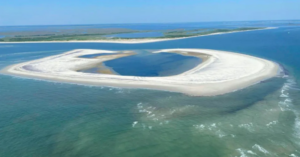Over the past five years, sand has naturally collected off the coast of New Jersey, resulting in a new, 40-hectare island.
The site reformed many times due to weather, the tide, and other natural factors, but in 2018, an emergent swash platform shoal formed and remained intact through several tide cycles and a recent nor’easter.
At first, the area – now referred to as Horseshoe Island – was quiet. But in 2021, biologists confirmed that more than 1,000 birds of various species were using the site for nesting.
Many of the nesting species – including black skimmers, red knots, and piping plovers – are endangered, threatened, or species of concern.
The birds may have begun using the site as early as 2020, but officials will never know because the site wasn’t monitored that year due to the pandemic.
“The use of this island was truly unprecedented in this part of New Jersey in terms of avian species diversity and abundance, particularly among species of conservation concern,” government officials said in an island management plan document.
In April, the New Jersey Department of Fish and Wildlife and U.S. Fish and Wildlife Service announced the area, which is off the coast of Little Beach Island, will be closed between March 1 and September 30 for the next five years.
Read more: The Weather Network
Ask me anything
Explore related questions





